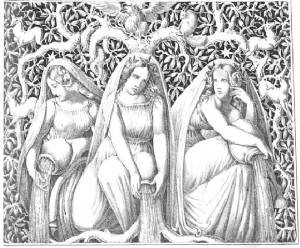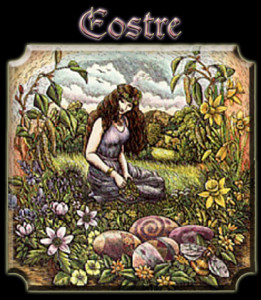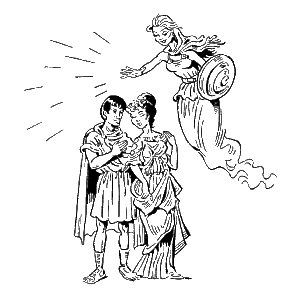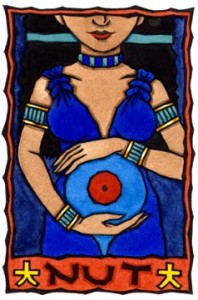Today is Ash Wednesday, an important day to the historical Knights Templar as well as esoteric Christians in ages past. It begins a sacred 40-day period during which we try to give up certain pleasures or things that we are better off without anyway.
Category Archives: Holy Days
Calendar of the Year’s Holy Days & Observances
Mother Earth Day Today! Observances & Practices for Most Celebrated Holiday
International Earth Day – Mother Earth Day
 Every 22nd of April, humanity celebrates International Mother Earth Day & Earth Day
Every 22nd of April, humanity celebrates International Mother Earth Day & Earth Day
By Risa D.
As more than a billion people participate in Earth Day activities every year, Earth Day has become the world’s largest civic observance. The massive concern to build right relations between humanity and the living being we call Earth is evidence of humanity’s love of the Mother. In 2009 the United Nations General Assembly proclaimed April 22 International Mother Earth Day, with a significant resolution affirming “the interdependence existing among human beings, other living species (the kingdoms – mineral, plant, animal & human) and the planet itself, the Earth which we all inhabit.” The Earth is our home.
Celebrating Earth Day helps us define new emerging processes (economic, social, political) focused on the well-being of the kingdoms. Through these humanity seeks to raise the quality of life, foster equality and begin to establish Right Relations with the Earth. We dedicate ourselves to bringing forth balance and a relationship of Harmony with all of nature. Learn about planting a billion trees (the Canopy Project); participate in 1.5 billion acts of Green. Disassociation (towards Earth) is no longer viable. We lose our connection to life itself. Participation is viable – an anchor, refuge and ordained service for all of life on Earth. www.earthday.org/; www.harmonywithnatureun.org;
www.un.org/en/events/motherearthday/
From Farmers Almanac, “ On Earth Day, enjoy the tonic of fresh air, contact with the soil, companionship with nature! Go barefooted. Walk through woods find wildflowers and green moss. Remain outside, no matter the weather!” Nature, Earth’s most balanced kingdom, heals us. The New Group of World Servers is preparing for May 3rd, Wesak Buddha Taurus solar Festival. We prepare through asking for and offering forgiveness. Forgiveness purifies and like nature, heals. (284)
Esoteric Astrology as news for week April 22 – 29, 2015
ARIES: Money concerns are shared by you and Taurus this month. Pull back on spending for a while assessing exactly what you need and no more. Before any actions with money, tithe to those in need. Do not refrain from this, even if you feel you have no money. We can always give even small amounts. This ensures constant loving resources flowing into our lives from spiritual sources. After giving, financially organize.
TAURUS: Read Aries, following the suggestions. And now about your money and resources. You have resources all around – hidden away in containers (boxes, bags, drawers, garages, storage units, etc.) – kept as historical remembrances. However, now a new resource is needed. Trade the old for the new so new money can come in. Ask if you need assistance in organizing. Know when things are used their light shines forth.
GEMINI: Allow yourself contemplation and solitude. Your own thoughts need to be listened to now. You may feel dreamy during the day and/or dreams become vivid through the night. Record all dreams your Dream Journal, then talk about them. Dreams are messages clarifying yesterdays, releasing emotions, future prescriptions. Over time, chronicling our dreams, they become understandable.
CANCER: More and more you must come out of your shell. You’re a cardinal (initiating things) sign (a leader) that knows the future must be prepared for in ways different than before. You’re the nurturing “great mother”, realizing food must be grown and necessities must be sustained for family, friends, pets and humanity later on. Tend to all personal health matters first. Then, “carry on.”
LEO: As you observe those you work with, looking for constancy, trust, confidentiality and abilities, you’re also being observed. You’re influencing many at this time. Let your work ethic be a model for others. It’s important to acknowledge, praise and recognize everyone. We, you included, evolve through praise, recognition and what we create. We see, recognize and applaud your gifts and endeavors.
VIRGO: Tend to resources and money with care. If you do so, ponder upon and prepare to travel to places that transform your mind and heart, cast a radiance of dappled light onto your body, and allow you to adapt to new ways of life, food, people and cultures. It also could be time to return to school or a certain study. Some great learning calls to you – heart to heart.
LIBRA: Thinking, planning and organizing finances for the future is appropriate now. A good idea is purchasing gold and silver instead of retirement plans and/or other ideas the banks have created. Find someone reputable who ethically deals in gold and silver.Discuss with others (family, intimate, financial advisor, etc.) what and how you are planning for your death. Make a plan. Legalize it.
SCORPIO: With all your present relationships, partnerships and interactions with others, you consider new ways of relating that include more Goodwill and Kindness that create Right Relations. Having the intention to act with greater depth and love is alchemical, creating a magnetic aura around. It attracts others seeking the love you so potently (or potentially) emit. Think on these things. Do you need new sunglasses?
SAGITTARIUS: Lot of little things need your attention. So often you see the big issue, the grand scale, the great philosophical over-view. It’s an excellent celestial foundation of knowing. However, little parts and pieces in your world need to be tended too. Survey your daily agenda, tasks and environments for what calls calling for care and attention. Then heavens and earth meet, heart and mind, body and Soul integrate and balance.
CAPRICORN: Something new is asking to come forth. A new path perhaps, new garden, new foundation of life. May a new child or a new creative endeavor at home, in rooms around the house. Something repaired, repainted, re-floored, re-surfaced, carpeted or perhaps a new art form of creativity. Everything must be fun, lively, filled with color, music, dance, fire, friends, nurturing foods and children at play. A new comfort.
AQUARIUS: Careful with communication. You could be too quick for others to follow and/or understanding. You could also be potentially frustrated with others, thinking them too slow. Act instead with kindness & understanding. No one in the zodiac is as fast as you, talks quicker, or understands new realities with your comprehension. Look with love and compassion upon your fellow travelers. They all wish they had your mind.
PISCES: The environments around you are in need of change. You need a change of environment, neighborhood, yard, and room. Some Pisceans might actually need a completely new home. If this is you, begin with a list of all you need in a home, town, village, etc. Then draw & write down what your perfect home would be. Working on this daily, hourly creates a magnet field within you that attracts your new home directly to you. And the resources needed. Begin now. There is happiness in change.
~Risa – writer, teacher, founder & director…
Esoteric & Astrological Studies & Research Institute
~Email: risagoodwill@gmail.com
~Web journal: www.nightlightnews.com
~Facebook: Risa’s Esoteric Astrology for daily messages
April Esoteric Alternative Holidays

April 14 – Norse Festival of Sommarsblot. The sommarsblót is a salutation of the rising of the sun over the darkness, in a ceremony that marks the beginning of the second half of the year.
The festival to welcome Summer. The Norse calendar was divided simply in two seasons: summer and winter. At the time around the Christian Easter, which similarly is celebrated according to the lunar calendar, this holiday is also called the Summer Finding, and may be celebrated as early as March 23. It is the day the light of the sun overpowers the darkness. – http://secondsightresearch.tripod.com/bodyandsoul/id19.html
April 15 – Celtic Tree Month of Willow begins
– Feast of Tellus Mater (Roman)
– Festival of Ba’ast, Feast of Bast (Egyptian cat goddess)
April 16 – St. Padarn’s Day (Celtic)
– Feast of St. George (Byzantine)
April 15-17 Feast of the Seas – Honoring God-Goddess as Olokun-Yemaya (Yoruba/Santeria) and Okeanos-Tethys (Old Greek).
April 18 – Thargelia (Greek)
-Rava Navami (Hindu)
April 22 Earth Day – Day to honor the Earth and to meditate on Deity manifesting as Mother Earth
– Festival of Isthar (Babylonian)
– Feast of the Divine Couple (Japanese)
– Feast of Elaphebolia (Greek)
– Odin’s Day – Norse festival.
April 23 – European Festival of the Green Man, Spirit of Vegetation and Forests
– Sigurd’s Day (Germanic)
April 25 – Holy Prophet Mani’s Day (he was born on this day in the 3rd century A.D.) Manichaeans were his followers, predecessors of modern gnostics
– Spring Festivals – Dedicated to Herne, Pan, Horned God.
Roman Robligalia – Corn Mothers (Ceres and Demeter) and Harvest.
Arbor Day – Day to honor trees, to plant trees, and to meditate on Deity manifesting as trees, such as Goddesses Helice/Willow (Greek) and Yggdrasill/Ash (Norse).
April 30 – Walpurgisnacht (Germanic)
– Floralia Ends (Roman)
– Beltane Begins at Sundown (Celtic, Wiccan)
– Salus
– St. Sophia’s Day
April 30 – May 2 Old Norse Feast.
Beltaine – Celtic festival marking the arrival of summer in ancient times.
Esoteric April Holidays – and Easter, too
MOVABLE HOLLY DAYS, SOMETIMES IN MARCH, USUALLY IN APRIL
Palm Sunday – Christian feast marking Jesus’ entrance into Jerusalem to teach love and justice for all humanity and to sacrifice Himself for the liberation and redemption of all.
Holy Thursday: Last Supper of Jesus – He washed the feet of His male and female disciples, gave them bread and wine as His body and blood, and told of the Paraclete (Our Mother, the Holy Spirit) who would come after Him.
Passover – Jewish festival recalling their deliverance from slavery in Egypt and celebrating freedom from oppression.
Easter Sunday – Christian celebration of Jesus’ resurrection by the power of the Holy Spirit.
Read all about Easter’s esoteric meaning, Palm Sunday, etc. here:
11 Days in Spring, Kristian Easter Cycle Events
April 1 Day of Venus – Goddess of Love vanquishes Mars, God of War, with love (Roman).
– Day of Kali – Dark Mother who liberates (Hindu).
– Loki’s Day, Norse Teutonic trickster god
– Hathor’s Day (Egyptian)
April 1-4 Iroquois Thunder Ceremony – In thanksgiving for the rains. Iroquois believe Sky Woman descended from the Sky and Created Earth.
April 2-10 Hindu Festival honoring Maha Devi as Gauri – life, growth, and fruition.
April 3 – the Ascension of Persephone
– Buddha’s Birthday
April 4 Greek Megalesia of Cybele – Games dedicated to the Great Mother (Greek).
April 5 Roman Day of Fortuna – Goddess of Fate (Roman).
April 7-8 Feast of Greek Goddess Artemis (Roman Diana) – who represents the feminine in Nature and protects women throughout their lives.
April 8 – Zen Buddhist celebration of Buddha’s birth (563 BCE)
Spring Equinox, End of March Holidays
 March 19 – Eyvind Kinnrifi (Odinist / Norse)
March 19 – Eyvind Kinnrifi (Odinist / Norse)
– Athena’s Day (Greek)
– Minerva’s Day (Roman)
March 20 – Ala Festival (Nigerian)
– Iduna’s Day (Norse)
– Alban Eilir (Celtic, Druid holiday)
– Spring Harvest Festival (Egyptian)
March 20-21 Old Sumerian Vernal / Spring Equinox Festival – celebrating the return of Dumuzi (also spelled Tammuz or Tamuzi), the God of Life and Death from the Underworld to be with Inanna (Goddess of Life) for the verdant part of the year.
March 20 or 21 Spring Equinox aka Vernal Equinox aka Ostara. Marks the beginning of Spring. Days and nights are exactly equal, the sun rises and sets in the exact east and west. This holiday represents the first creation, but also the annual creation (planting so crops grow each year) and most symbolic, the perpetual creation. Fertility symbols abound such as eggs and rabbits. Spring or Vernal Equinox begins a forty day period which culminates with May Day, another fertility Spring festival of ancient origin. This forty day period is one of four such in the esoteric Church year. The other three forty day periods are: Fall Equinox (Sept 22 or 23) to Halloween / AllSaints Day (Oct. 31, Nov.1), Dec. 25 to Candlemas (Feb 1 or 2) and of course, Lent. Lent is the forty day period beginning on Ash Wednesday and ending on Easter Sunday every year.
March 23 – Venus’ Day
– Summer Finding (Norse)
March 24: Feast Day of Archangel Gabriel whose name means, “The High One’s Hero,” or “Hero of God,” or “Power of God,” or “Might of God.” Note this day comes one day before Annunciation Day when Gabriel performed his most famous task. Since 1970, the Catholic Church no longer recognizes this day for Gabriel, ending a thousand year plus tradition by opting to lump him in with Raphael and Michael for a Feast of the Holy Archangels Day on Sept 29. Originally the Church had an angel for each of the four “corners” of the year, the solstices and equinoxes. It was the Church’s only recognition of these “pagan” holy days.
– Britannia’s Day
– Heimdall’s Day (Norse)
March 25 – Annunciation Day, Christian feast commemorating Blessed Maria’s choosing to conceive Child Jesus by the power of the Holy Spirit and to become a catalyst of liberation and redemption
– Hilaria’s Day (Roman)
– Return of the Goddess
– Mars and Neria (Roman)
March 27 – Greek Galaxia, Adoration of Cybele
– Smell the Breeze Day (Egyptian)
March 28 – Birthday of Kwan Yin (Chinese)
– Sacrifice at the Tombs (Roman)
– Pallas’ Day (Greek)
March 29 – Festival of Ishtar (Babylonian)
– St. Mark’s Day
– Delphinia (Greece)
– Expulsions of the Demons of Bad Luck (Tibetan)
March 30 – Eostre’s Day (Germanic) This is the goddess from whose name the Northern Europeans got the word Easter. She is a Spring goddess. Southern Europeans and Eastern Orthodox Christians call the holiday Pascha or the Passion, they do not use the term Easter because they did not have that particular goddess.
March 31 – Luna (Roman)
Cathar Remembrance Day, Hypatia, Montsegur, Shiva, Marduk

March 10 – Hypatia’s Day (Greek). To fall in love with this awesome female gnostic saint, one needs only to watch this movie about her: Agora
March 11 – Hercules Day
– Great Night of Shiva, Vigil and feast for Transcendence
March 12 – Feast of Marduk (Mesopotamian – which is modern-day Iraq and Syria)
March 14 – Cathar Remembrance Day. On March 16 their last fortress fell, but March 14 is a Cathar holy day and on that last March 14, 1244, they performed a special Easter Rite (it was also Easter that year). Two days later they were burnt alive by the Church of Rome, a day — March 16 — also remembered by modern gnostics called Montsegur Day (see below).
– Roman Equirria – Horse race dedicated to Mars.
March 14 – 18 Holi-Hindu Festival – celebrating the courting of God Shiva by Goddess Parvati, and the efforts on Her behalf by Kama (God of Love) and Rati (Goddess of Passion). Hindus believe all Gods and Goddesses are aspects of the one Great God-Goddess Maha Deva-Maha Devi, the limitless, attributeless, immanent, and transcendent Brahman. Shaivas are devoted to God Shiva in all His aspects.
March 15 – Ides of March (Roman)
– Rhea’s Day (Greek)
– Holiday of Cybele (Anatolian, Roman)
March 15-27 Phrygian Festival of Cybele and Attis – Goddess of Earth/Wild Animals and God of Vegetation, Death and Rebirth
March 16 – Montsegur Day, Gnostic holy remembrance day of the slain Cathar gnostics burned at the stake on this day in 1244 A.D.
– Dionysos’ Festival (Greek)
– Bacchus’ Day (Roman)
March 17 – St. Patrick’s Day – Old European festival marking rebirth of the Green Man / Green George (God as Deciduous Vegetation); merged with the Christian feast of St. Patrick.
– Festival of Astarte – Celebrating the Canaanite Holy Land Goddess of Love
– Liberalia (Roman)
March Esoteric Holidays

March 1 – Roman New Year, also called Matronalia, the Kalends of March. The word “Mother” is the root of Matronalia and it was a sort of mother’s day and sacred marriage day to ancient Romans. Men would give gifts to wives & mothers. When a man presented the gift to his wife on this day, she would then praise her husband as part of an annual repeat of the marriage ceremony. Women would take flowers and incense to the temple of Mother Goddess Juno Lucina in honor of its construction on March 1st, 375 B.C.
– St. David’s Day
March 1-2 Mahashivaratri – Hindu fast, night vigil, and feast for God-Goddess Shiva-Shakti (union of Will and Power), who dances to create, destroy, and re-create the universe. Tantric Hindus believe Shiva is within all men and Shakti within all women; they recognize gender equality and reject caste.
March 2 – Holy Wells’ Day (Norse)
March 3 – Aegir’s Day (Teutonic)
– Japanese Doll Festival
March 4 – Feast of Rhiannon (Welsh)
– Egyptian Day
– Anthesteria (Greek)
– Mothering Day (English)
March 5 – Navigium Isidis – Old Egyptian festival honoring Goddess Isis as Lady of the Moon and Ruler of the Sea; celebrated with the launching of a boat of offerings.
– Purim 2015, the day Esther saved her people from genocide. Let’s think of others in the world presently at risk of genocide, such as the middle eastern Christians
March 6 – Mars Day, Mars if the god this month gets its name from
– Alamo Day. “Remember the Alamo!”
March 7 – Bird and Arbor Day
March 8-9 Feast of Old Greek Goddess Artemis (Roman Diana) – as protector of wild animals and vegetation
March 8 – Birthday of Mother Earth (Chinese)
– International Women’s Day (esotericists often observe this day by reading poetry, wearing beautiful purple and/or red hats…)
March 9 – Mother Goddess Day, Honoring all Mother Goddesses
– Feast of the 40 Martyrs (Greek) also called 40 Saints Day
– Celebration of Aphrodite and Adonis (Greek), a Sacred Marriage
Late February Esoteric Alternative Holidays

Feb 21 – 28 Lesser Eleusinian Mysteries – Old Greek festival celebrating the marriage of Goddess Kore and God Dionysos, following their return from Elysium.
Feb 22 Caristia – Old Roman festival for renewing family ties and patching up quarrels.
Feb 26 Egyptian Day of Nut – Goddess of Healing and Fertility.
Feb 28 Saxon Cake Day – cakes offered to the God and the Goddess.
Ash Wednesday has Esoteric Meaning of Defeating Evil, Purification
Ash Wednesday is today. It was an important holiday to the Knights Templar who followed four of these forty day fasts each year, this one — Great Lent — being the greatest.
 The Hidden Lighthouse says:
The Hidden Lighthouse says:
“In the Catholic churches the branches of the sago palm are blessed on Palm Sunday. The acceptable way to dispose of such blessed palms is to burn them.[The ashes are then saved all year until Ash Wednesday comes]
The ashes from these burnt palms are applied to the foreheads of Catholics on Ash Wednesday and the remainder of the ashes are left in shallow bowl at the entrance of the church as a reminder of our ashen mortality during the rest of Lent.
There in that ancient ritual of the Catholic church is the phoenix, the palm, and the ashes all tied in together. Plus it helps one to see the deep spirituality that [J.K.] Rowling has embedded in the stories of little Harry Potter, the quintessential Ego, a young kid taking on the ancient dark forces of evil and conquering them.
Smith also notes the connection between phoenix and the palm tree because Phoenix in Greek means palm tree.”
Gnosis.org says:
“The significant rite of the beginning of Lent is the signing with the ashes on Ash Wednesday. The sign of the cross is traced upon the forehead with the words, “Remember Thou, O soul, that thy body is dust and unto dust it shall return.” These words signify a release from the identification of the self with the mortal and corruptible body and personality. A detachment from our conventional identification with our mortal shell can result in an altered state of consciousness where our bodies can communicate to us a spiritual reality and we can develop in actuality a more caring attitude toward it. St. Francis often referred to his mortal frame as his humble and dutiful “donkey” that bore him through this life, like the donkey that bore the blessed Virgin to Bethlehem.” — Read the rest of this Homily for Ash Wednesday here.
“Today is Ash Wednesday, starting Lent, the lead-up to Easter. On Ash Wednesday traditionally the palms from Palm Sunday are burned and the ashes are placed by the priest on devotees’ mid-forehead (same place as the spiritual eye).
Mardi Gras Shrove Tuesday Esoteric Meaning
Mardi Gras, Carnival, Fat Tuesday, Shrove Tuesday, Pancake Tuesday, Fastnacht
 The date of Mardi Gras / Shrove Tuesday/ Fastnacht varies based on Easter, the Full Moon and Equinox
The date of Mardi Gras / Shrove Tuesday/ Fastnacht varies based on Easter, the Full Moon and Equinox
Besides yesterday, Feb 17, 2015, Here are future dates of Mardi Gras / Carnival / Shrove Tuesday:
- February 9, 2016
- February 28, 2017
- February 13, 2018
- March 5, 2019
- February 25, 2020
- February 16, 2021
- March 1, 2022
- February 21, 2023
The history of a Mardi Gras celebration existed many years before Europeans came to the New World. Some time in the Second Century, during mid-February (usually February 15 according to the Julian calendar), Ancient Romans would observe what they called the Lupercalia, a circus-type festival which was, in many respects, quite similar to the present day Mardi Gras. This festival honored the Roman deity, Lupercus, a pastoral God associated with Faunus or the Satyr. Although Lupercus is derived from the Latin Lupus (meaning “wolf”), the original meaning of the word as it applies to Roman religion has become obscured over the passage of time.
When Christianity arrived in Rome, the dignitaries of the early Church decided it would be more prudent to incorporate certain aspects of such rituals into the new faith rather than attempt to abolish them altogether. This granted a Christian interpretation to the ancient custom and the Carnival became a time of abandon and merriment which peceded the Lenten period (a symbolic Christian pentinence of 40 days commencing on Ash Wednesday and ending at Easter). During this time, there would be feasting which lasted several days and participants would indulge in voluntary madness by donning masks, clothing themselves in the likeness of spectres and generally giving themselves up to Bacchus and Venus. All aspects of pleasure were considered to be allowable during the Carnival celebration and today’s modern festivites are thought by some to be more reminiscent of the Roman Saturnalia rather than Lupercalia, or be linked to even earlier Pagan festivals.
From Rome, the celebration spread to other European countries. In medieval times, a similar-type festivity to that of the present day Mardi Gras was given by monarchs and lords prior to Lent in order to ceremoniously conscript new knights into service and hold feasts in their honor. The landed gentry would also ride through the countryside rewarding peasants with cakes (thought by some to be the origin of the King Cake), coins (perhaps the origin of present day gifts of Mardi Gras doubloons) and other trinkets. In Germany, there still remains a Carnival similar to that of the one held in New Orleans. Known as Fasching, the celebrations begin on Twelfth Night and continue until Shrove Tuesday. [In German-America, that is the communities in the USA with large populations descending from German Americans, such as certain towns in West Central Maryland and Pennsylvania where I grew up, special “doughnuts” are still sold for this holiday called Fasnachts are served. The word Fasnacht is derived from Fasching mentioned above and a Pennsylvania Dutch holiday called Fastnacht “fast night”.]
To a lesser degree, this festivity is still celebrated in France and Spain. A Carnival season was also celebrated in England until the Nineteenth Century, originating as a type of “renewal” festival that incorporated fertility motifs and ball games which frequently turned into riots between opposing villages, followed by feasts of pancakes and the imbibing of alcohol. The preparing and consumption of pancakes on Shrove Tuesday (also known as “Pancake Day” or “Pancake Tuesday” and occurring annually between February 2 and March 9, depending upon the date of Easter) is a still a tradition in the United Kingdom, where pancake tossing and pancake races (during which a pancake must be tossed a certain number of times) are still popular. One of the most famous of such competitions, which takes place in Olney, Buckinghamshire, is said to date from 1445. It is a race for women only and for those who have lived in the Parish for at least three months. An apron and head-covering are requisite. The course is 415 yards and the pancake must be tossed at least three times during the race. The winner receives a kiss from the Ringer of the Pancake Bell and a prayer book from the local vicar. “Shrove” is derived from the Old English word “shrive,” which means to “confess all sins.”
It is generally accepted that Mardi Gras came to America in 1699 with the French explorer, Sieur d’Iberville. The festival had been celebrated as a major holiday in Paris since the Middle Ages. Iberville sailed into the Gulf of Mexico and, from there, launched an expedition along the Mississippi River. By March 3, 1699, Iberville had set up a camp on the West Bank of the River…about 60 miles South of the present day City of New Orleans in the State of Louisiana. Since that day was the very one on which Mardi Gras was being celebrated in France, Iberville named the site Point du Mardi Gras in honor of the festival. According to some sources, however, the Mardi Gras of New Orleans began in 1827 when a group of students who had recently returned from school in Paris donned strange costumes and danced their way through the streets. The students had first experienced this revelry while taking part in celebrations they had witnessed in Paris. In this version, it is said that the inhabitants of New Orleans were swiftly captured by the enthusiasm of the youths and quickly followed suit. Other sources maintain that the Mardi Gras celebration originated with the arrival of early French settlers to the State of Louisiana. Nevertheless, it is known that from 1827 to 1833, the New Orleans’ Mardi Gras celebrations became more elaborate, culminating in an annual Mardi Gras Ball. Although the exact date of the first revelries cannot be determined, the Carnival was well-established by the middle of the Nineteenth Century when the Mystick Krewe of Comus presented its 1857 Torchlight Parade with a theme taken from “Paradise Lost” written by John Milton.
In French, “Mardi Gras” literally means “Fat Tuesday,” so named because it falls on the day before Ash Wednesday, the last day prior to Lent…a 40-day season of prayer and fasting observed by the Roman Catholic Church (and many other Christian denominations) which ends on Easter Sunday. The origin of “Fat Tuesday” is believed to have come from the ancient Pagan custom of parading a fat ox through the town streets. Such Pagan holidays were filled with excessive eating, drinking and general bawdiness prior to a period of fasting. Since the modern day Carvinal Season is sandwiched between Christmas and Lent, with Christmas Day being December 25 on the Gregorian Calendar as set by the Roman Catholic Church, this means that other Holy Days are “floating” in nature. Easter always falls on a Sunday, but it can be any Sunday from March 23 through April 25, its actual date being the Sunday which follows the first Full Moon after the Spring Equinox. Mardi Gras is always 47 days prior to this alloted Sunday (the 40 days of Lent plus seven Sundays). The beginning of the Carnival Season itself, however, is also fixed…being January 6, which is the Feast of the Ephiphany, otherwise known as Little Christmas or Twelfth Night. Since the date of Mardi Gras thus varies, the length of the Carnival Season also varies accordingly from year-to-year. The origin of the word “Carvinal” is from the Latin for “farewell to the flesh,” a time when one is expected to forego earthly pleasures prior to the restrictions of the Lenten Season, and is thought to be derived from the feasts of the Middle Ages known as carnis levamen or “solace of the flesh.”
In New Orleans in 1833, Bernard Xavier de Marigny de Mandeville, a wealthy plantation owner, solicited a large amount of money in order to help finance an organized Mardi Gras celebration. It was not until 1837, however, that the first Mardi Gras Parade was staged. Two years later, a description of the 1839 Parade noted that it consisted of a single float. Nonetheless, it was considered to be a great success and apparently, the crowd roared hilariously as this somewhat crude float moved through the streets of the city. Since that time, Mardi Gras in New Orleans has been an overwhelming success, continuing to grow with additional organizations participating each year.
 The traditional colors of Mardi Gras are purple (symbolic of justice), green (symbolic of faith) and gold (symbolic of power). The accepted story behind the original selection of these colors originates from 1872 when the Grand Duke Alexis Romanoff of Russia visited New Orleans. It is said that the Grand Duke came to the city in pursuit of an actress named Lydia Thompson. During his stay, he was given the honor of selecting the official Mardi Gras colors by the Krewe of Rex…thus, did these colors also become the colors of the House of Romanoff. [Katia inserts: In all my years as a Romanoff, I have never heard these being the Romanoff colors. The vestments worn by bishops and priests on Ash Wednesday are purple and gold, so that probably influenced the choice.]
The traditional colors of Mardi Gras are purple (symbolic of justice), green (symbolic of faith) and gold (symbolic of power). The accepted story behind the original selection of these colors originates from 1872 when the Grand Duke Alexis Romanoff of Russia visited New Orleans. It is said that the Grand Duke came to the city in pursuit of an actress named Lydia Thompson. During his stay, he was given the honor of selecting the official Mardi Gras colors by the Krewe of Rex…thus, did these colors also become the colors of the House of Romanoff. [Katia inserts: In all my years as a Romanoff, I have never heard these being the Romanoff colors. The vestments worn by bishops and priests on Ash Wednesday are purple and gold, so that probably influenced the choice.]
The 1892 Rex Parade theme (“Symbolism of Colors”) first gave meaning to the representation of the official Mardi Gras colors. Interestingly, the colors of Mardi Gras influenced the choice of school colors for the Lousiana arch-rival colleges, Louisiana State University and Tulane University. Whe LSU was deciding on its colors, the stores in New Orleans had stocked-up on fabrics of purple, green and gold for the upcoming Mardi Gras Season. LSU, opting for purple and gold, bought a large quantity of the available cloth. Tulane purchased much of the only remaining color…green (Tulane’s colors are green and white).
Today, Louisiana’s Mardi Gras is celebrated not only in New Orleans, but also in numerous smaller cities and towns around the State and in the neighboring Gulf Coast Region. Similar celebrations are also held in the Brazilian city of Rio de Janeiro…arguably the world’s most elaborate Carnival location with its Samba Dromo parades, which annually attract a huge number of tourists from all corners of the globe. Regardless of where the festivals take place, however, all share a common party atmosphere inherently associated with the celebrations.
* * * * * * * * * * * *
Mardi Gras is always followed by Ash Wednesday. See the next entry for that holiday